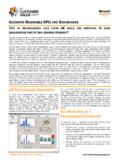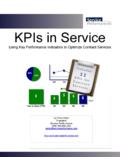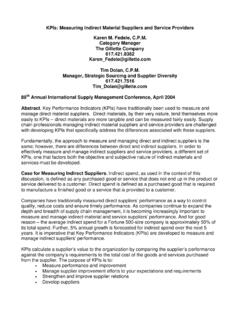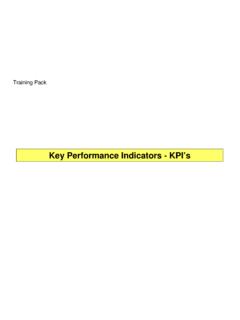Transcription of Killer KPIs for Leadership - NetSuite OpenAir | Leading ...
1 Killer kpis for LeadershipService Compass: Charting the Course to Professional Service ExcellenceJanuary 2009 Service Performance Insight6260 Winter Hazel DriveLiberty Township, OH 45044 USAT elephone: Boroughwood Place Hillsborough, CA 94010 USAT elephone: kpis for Leadership1 TABLE OF CONTENTSI ntroduction .. 3 Service Performance Pillars and the Service Maturity Model .. 3 Leadership Styles .. 5 Confidence in Leadership .. 6 Organizational Vision, Mission & Strategy .. 6 Ease of "Getting Things Done".. 8 Goal-Measurement Alignment .. 9 Conclusions .. 10 About Service Performance Insight .. 11 FIGURESF igure 1: Demographics for the 2009 PS Maturity Benchmark .. 3 Figure 2: The Five Service Performance Pillars.
2 3 Figure 3: Business Blueprint Pyramid .. 8 TABLEST able 1: Confidence in PS Leadership .. 6 Table 2: Organizational Vision, Mission and Strategy Clarity .. 6 Table 3: Ease of "Getting things done" in PS .. 9 Table 4: Goals / Measurement Alignment .. 9 PSA solutions deliver a significant ROIK iller kpis for LeadershipFind out more: contact OpenAir at or visit all know that best in class professional service organizations (PSOs) are based on exceptional consultants. Wealso know that it takes effective Leadership to inspire organizations to achieve greatness. But what we haven tknown until now is the absolute monetary effect of professional service (PS) Leadership on the bottom line.
3 In thiswhitepaper we are publishing for the first time the Killer KPI s (Key Performance Indicators) for Leadership . Wethink you will be as astounded as we were to discover that poor Leadership permeates every facet ofprofessional service organizational performance. This SPI Research White Paper analyzes data from the upcoming PS Maturity Model 2009 benchmark reportbased on responses from over 170 professional service organizations. The surveys were completed in October and November of 2008. Demographics for the responding organizations are shown below:Figure 1: Demographics for the 2009 PS Maturity BenchmarkSource: Service Performance Insight, January 2009 SERVICE PERFORMANCE PILLARS AND THE SERVICE MATURITY MODELIn 2007 Service Performance Insight introduced the original version of the The Professional Service MaturityModel , which benchmarks the correlation between professional service organizational performance and theadoption of best practices and business process maturity.
4 In early 2009, SPI Research will publish its latest version of this study focuses on professional service excellence across fiveService Performance 2: The Five Service Performance Pillars1. Vision, Strategy, Leadership and Culture 2. Finance and Operations 3. Human Capital Alignment 4. Service Execution 5. Client Relationships Source: Service Performance Insight, January 2009 Killer kpis for LeadershipFind out more: contact OpenAir at or visit Research developed a model that segments and analyzes a PSO into five distinct areas of performance thatare both logical and functional. 1. Vision, Strategy and Culture:(CEO) A unique view of the future and the role the service organizationwill play in shaping it.
5 A clear and compelling strategy provides a focus for the organization and galva-nizes action. Effective strategies focus on target customers, their business problems, and how a solutionsolves those problems differently, uniquely, or better than its competitors. For a service strategy to beeffective, the role and charter of the service organization must be defined, embraced and supportedthroughout the company. Depending on whether the service strategy is to primarily support the sale ofproduct or to drive service revenue and margin; service organization goals and measurements will Finance and Operations: (CFO) The ability to manage services profit and loss to generate revenue andprofit while developing repeatable operating processes.
6 Elements of this pillar provide long-term financialstability, which enables PSOs to manage growth and provide an acceptable level of return to Human Capital Alignment:(HR) The ability to attract, hire, retain and motivate employees. Withchanging workforce demographics, human capital strategy has increased in importance. As executiveswork to manage costs, they must assure clients have the best/cost-effective personnel working on projects. As PSOs adopt new staffing models designed to achieve these goals, they must also be diligentto keep their best people on-board and motivated. 4. Service Execution:(Engagement/Delivery) the methodologies, processes and tools to effectively schedule, deploy and measure the quality of the service delivery process.
7 Service execution involves anumber of factors: from assuring utilization rates remain high, to delivering services in a predictable and acceptable time frame, to reducing cost while improving project quality and harvesting knowledge. 5. Client Relationships:(Sales and Marketing) the ability to effectively communicate with employees, partners and customers to generate and close business and win deals. Effective client managementinvolves improving relationships to better understand client needs, while ensuring clients will continue to buy and provide references and testimonials. Within each of the Service Performance Pillars, SPI Research developed guidelines for process maturity. Theseguidelines cut across the five service dimensions to illustrate examples of business process maturity.
8 This study has been developed to measure the correlation between process maturity and service performance model is built on the same foundation as the Carnegie Mellon Capability Maturity Model (CMM), which hasbeen adopted for software development; but is specifically targeted toward billable PSOs, that either exclusivelysell and execute professional services, or complement the sale of products with services to optimize a product suse. The five maturity levels include: Level 1 Initiated:At maturity Level 1, processes are ad hoc and fluid. The business environment ischaotic and opportunistic, and the focus for a PSO is primarily on new client acquisition and referencebuilding. Often professional service employees at this level are chameleons able to provide presalessupport one day and develop interfaces and product workarounds the next.
9 Success depends on thecompetence and heroics of people in the organization, and not on the use of proven processes, methodsor tools. Killer kpis for LeadershipFind out more: contact OpenAir at or visit Level 2 Piloted: At maturity Level 2, processes have started to become repeatable. Best practices maybe demonstrated in discrete functional areas or geographies but they are not yet documented and codi-fied for the entire organization. Basic processes have been established for the five Professional ServicesPerformance Pillars but they may not be universally embraced. Level 3 Deployed: At maturity Level 3, the PSO has created a set of standard processes and operatingprinciples for all major service performance pillars but renegades and hold-outs may still has established and started to enforce financial and quality objectives on a global basis.
10 Level 4 Institutionalized:At maturity Level 4, management uses precise measurements, metrics and controls, to effectively control the PSO. Each service performance pillar contains a detailed set ofoperating principles, tools and measurements. Organizations at this level set quantitative and qualitativegoals for customer acquisition, retention and penetration, in addition to a complete set of financial andoperating controls and measurements. Level 5 Optimized:Maturity Level 5 focuses on continual improvement of all elements of the fiveperformance pillars. A disciplined, controlled process is in place to measure and optimize performancethrough both incremental and innovative technological improvements.












